Physical Address
304 North Cardinal St.
Dorchester Center, MA 02124
Pneumonia and other pulmonary infections involving the lower respiratory tract continue to be the most common cause of illness in children, affecting over 150 million children under 5 years of age each year worldwide, with 20 million related US hospitalizations annually. Despite the decrease in hospitalizations for pediatric pneumonia since the introduction of the pneumococcal conjugate vaccine in 2000, the rates of pneumonia presenting in the ambulatory care setting have not decreased. Because clinical signs and symptoms are poor predictors of pediatric pulmonary infections, and the value of microbial studies is limited, chest radiography with the use of standardized reporting criteria continues to be the best available diagnostic standard. Currently published definitions of pediatric pneumonia do not solely rely on radiographic criteria, but require several additional clinical features to be present. The value of lateral radiographs in diagnosis continues to be debated, but the hyperinflation that is a radiographic hallmark of pulmonary infections in young children is more reliably detected on the lateral radiograph than on the frontal radiograph.
In experienced hands, ultrasonography of the lung has proven able to diagnose pneumonia, validated in two recent meta-analysis studies. In the ambulatory care setting, performing routine chest radiography has not been shown to improve the outcomes of pulmonary infections in young children, and it is not indicated in first-time wheezing episodes presumed to be viral or reactive in etiology. The yield of radiography is greater in the presence of a high temperature and in the absence of a family history of asthma. Radiography is most helpful when an inconsistency exists among the data from history, physical examination, and observation. Negative chest radiography provides justification to withhold antibiotics in symptomatic children. Newer evidence-based recommendations suggest that valid indications for chest radiography are severe disease requiring hospitalization, confirmation or exclusion of diagnosis in the presence of an atypical presentation, assessment of complications, and exclusion of other causes of respiratory distress. Even in hospitalized individuals in intensive care, chest radiographs should be obtained based on clinical need rather than routine protocols. However, compliance with these, as well as antibiotic use guidelines, is suboptimal. Follow-up chest radiographs after 4 to 6 weeks are only recommended for children with recurrent pneumonia involving the same lobe, to look for underlying anatomic causes.
Maternal antibodies protect newborns against viral pulmonary infections, and bacterial infections are most common in this age group, usually caused by pathogens acquired during labor and delivery. With dropping maternal antibodies, viral infections become more prevalent between ages 2 months and 2 years. After this, bacterial infections again become more common. Tuberculosis, fungal infections, and parasitic infestations continue to add substantially to the disease burden of children who are immunocompromised or live in endemic areas.
The spectrum of pulmonary infections in childhood is categorized in Table 54.1 . In young children, the lungs can only respond to insult in a limited number of ways, and this response is more age specific than antigen dependent. Viral and bacterial infections frequently coexist, and radiographic criteria alone do not reliably distinguish between them. This is compounded by a reported high interobserver variability for interpretation of chest radiographs. Use of inexact terminology may hamper communication between radiologists and referring physicians, who agree with radiologists' interpretations in only 78% of cases, and antibiotics are frequently prescribed even when no bacterial agent can be proven.
| By Pathology, Clinical Presentation | By Primary Location | By Radiographic Feature |
|---|---|---|
| Acute focal Atypical Miliary or nodular Progressive or fulminant Aspiration “Pulmonary infiltrates with eosinophilia” Chronic or recurrent |
Trachea: tracheitis Large airways: bronchitis Small airways: bronchiolitis Small airways and parenchyma: bronchopneumonia Parenchyma Alveoli (“alveolitis”) Interstitium |
Alveolar Interstitial Volume loss (atelectasis) Pulmonary nodule(s) Necrosis, cavitation Lymphadenopathy Pleural effusion |
Viral pulmonary infections usually occur after the inhalation of infected air droplets. The clinical presentation depends on the infectious agent, patient age, and immune response (mainly cellular, T-cell–mediated immunity). In young children, degrees of mucosal swelling within the small-caliber terminal airways, which would not compromise air exchange in older individuals with relatively larger-caliber airways, lead to diffuse alveolar air trapping ( Fig. 54.1 ). In addition, more hypersecretion occurs in the inflamed airways in young children, contributing to mucous plugging of the airways; this leads to (sub)segmental atelectasis mimicking alveolar consolidations, which are frequently misinterpreted to represent bacterial pneumonia.
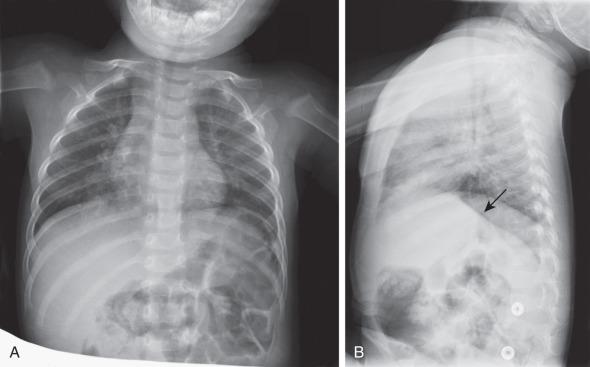
The most common viral agents causing pulmonary infections in childhood are listed in Table 54.2 .
| Organism | Characteristic Clinical Features | Typical Radiographic Findings and Sequelae |
|---|---|---|
| V iruses | ||
| RNA Viruses | ||
| RSV | Bronchiolitis (winter) | Interstitial pneumonia |
| HMV | Bronchiolitis (winter) | Interstitial pneumonia |
| Parainfluenza | Bronchiolitis (fall, spring) | Interstitial pneumonia |
| Influenza | “Bird flu,” pandemic flu | Interstitial pneumonia |
| Corona | SARS | Interstitial pneumonia |
| Measles | Nonimmunized, opportunistic | Atypical pneumonia |
| DNA Viruses | ||
| Adenovirus | Necrotizing bronchopneumonia | Bronchiolitis obliterans |
| CMV | Congenital, opportunistic | Ground-glass opacity |
| Varicella | Opportunistic | Pulmonary calcifications |
| EBV | Infectious mononucleosis, PTLD | Lymphadenopathy |
| B acteria | ||
| Aerobic/Facultative | ||
| Streptococcus pneumoniae | De novo, postviral | Acute focal pneumonia |
| Streptococcus A | Pharyngitis | Bronchopneumonia |
| Streptococcus B | Prematurity, neonatal pneumonia | Confusion with hyaline membrane disease |
| Staphyloccocus aureus | Postviral, embolic | Bronchopneumonia |
| Haemophilus influenzae B | Epiglottitis, vaccination | Atypical pneumonia |
| Bordetella pertussis | Whooping cough | Atypical pneumonia, “shaggy heart” |
| Pseudomonas | Opportunistic (CF) | Findings of CF, bronchiectasis |
| Legionella | Opportunistic | Atypical pneumonia |
| Anaerobic | Aspiration, debilitated | Lung necrosis, abscess |
| B acteria - like | ||
| Chlamydia trachomatis | Infancy, conjunctivitis | Interstitial pneumonia |
| Chlamydia pneumoniae | School age, bronchitis | Peribronchitis |
| Mycoplasma | School age, atypical pneumonia | Interstitial pneumonia, atypical |
| Mycobacterium tuberculosis | TB, opportunistic | Primary, miliary, postprimary |
| NTM | NTM disease, opportunistic | Mimics TB |
| F ungi | ||
| Aspergillus | Aspergilloma, invasive disease | Halo, air crescent signs |
| Histoplasma | Histoplasmosis | Mimics TB, calcified granulomas |
| Coccidioides | Coccidioiodomycosis | Mimics TB |
| Pneumocystis | Opportunistic | Ground-glass opacities, interstitial pneumonia |
| Candida | Opportunistic, debilitated | Nodules |
| P arasites | ||
| Paragonimus | Ingestion of uncooked crustaceans | Nodules, ring shadows |
| Echinococcus | Contact with infested dogs | Fluid-filled masses, with or without rupture |
| Others | Visceral larva migrans, Löffler syndrome | PIE |
Respiratory syncytial virus (RSV) is the most common cause of pulmonary infections in infants and young children. The disease can be virulent and is fatal in up to 1% of healthy infants, but those with chronic lung disease from prematurity and cardiovascular disease are at much higher risk. Clinical signs range from mild coryza to severe respiratory distress with wheezing, tachypnea, cyanosis, dyspnea, and retractions. Hypoxemia, possibly caused by a ventilation-perfusion imbalance, may be profound and last for several weeks. The diagnosis of RSV infection is made by examining the nasoepithelial cells by using direct fluorescent antibody detection.
Human metapneumovirus (HMV) is the second most common cause of viral pulmonary infections in young children after RSV. It affects children who are slightly older than those infected by RSV, and the disease is less severe, except when seen as a coinfection. HMV has a worldwide distribution and causes a disease spectrum indistinguishable from influenza and RSV infection, with the same seasonal variation.
Parainfluenza virus is a common community-acquired virus. Types 1 and 2 fluctuate biannually, typically in the fall, with type 3 common in the late winter or early spring, unlike RSV.
The onset is often more abrupt and intense than that of RSV or parainfluenza. The Asian avian influenza virus (H1N1) spread rapidly over many parts of the world from 2003 to 2007. Since 2009 a novel H1N1 infection resulting from antigenic shift of the virus has been reported to be associated with a higher rate of shock, acute respiratory distress syndrome (ARDS), and neurologic complications in children compared with seasonal (non-H1N1) infections.
Severe acute respiratory distress syndrome (SARS) is caused by a coronavirus, which was recognized in 2003, and in the following year, it was diagnosed in over 8000 patients, primarily in China, Taiwan, Hong Kong, Vietnam, and Toronto. After 2004 the outbreak appeared to have been contained; since then, SARS has only been sporadically reported. SARS typically has a brief prodrome of fever, with or without constitutional symptoms. This quickly progresses to severe respiratory symptoms by day 6 of the fever. It has an overall mortality rate of 10%, but children have constituted only 5% of reported cases; they tend to have a milder course, and no pediatric deaths have been reported. Recently, newer coronaviruses (NL63 and HKU1), which cause milder forms of respiratory disease, have been discovered.
Pneumonia as a complication of childhood measles is diminishing in frequency because of vaccination, but it is still occasionally seen in nonimmunized or immunosuppressed children. Atypical measles pneumonia followed exposure to measles or vaccination with the live vaccine and was characterized by a prodromal period of rash and flulike illness.
Adenovirus pneumonia is responsible for about 5% of respiratory tract disease in infants and children, with a peak age between 6 months and 5 years. Adenovirus has also been associated with a pertussis-like syndrome. Although often relatively benign, adenoviral infection may be severe and even fatal in young infants, particularly when caused by the recently identified serotype Ad14.
Cytomegalovirus (CMV) is a cause of congenital infection of the lungs, the liver, and the central nervous system, and causes hematologic changes of petechiae, purpura, hemolytic anemia, and atypical lymphocytes. These same systems are involved in acquired disease, but the disease is less severe. Children with a compromised immune status are at lifelong risk for CMV infection, and it is frequently seen in patients with acquired immunodeficiency syndrome (AIDS) and in children treated with cyclosporine.
Varicella (chickenpox) pneumonia is relatively rare, but immunocompromised children are at risk for progressive varicella and more severe pulmonary involvement, as well as for meningoencephalitis and hepatitis. These children are severely ill, with extensive rashes and high fever; chest pain and hemoptysis are frequent.
Epstein–Barr virus (EBV) infects B lymphocytes and pharyngeal and possibly pulmonary epithelial cells. It is associated with infectious mononucleosis, a common disease in older children and young adults, presenting with fever, pharyngitis, and adenopathy. The disease may be suspected if the tonsils and adenoid are markedly enlarged. EBV is frequently associated with posttransplantation lymphoproliferative disorder, lymphomas complicating immune deficiency disorders, and lymphocytic interstitial pneumonitis (with or without associated human immunodeficiency virus [HIV] infection).
Bilateral interstitial opacities with peribronchial thickening and hyperinflation (see Fig. 54.1 ), thought to represent viral bronchiolitis, are nonspecific and are, in fact, indicative of an acute pulmonary infection of any cause (viral or bacterial) in young children. Pleural effusions are rare in purely viral lung infections. Radiologic abnormalities often clear slowly and lag behind clinical improvement. Complications are superimposed bacterial infection (often hospital acquired) and postinfectious bronchiolitis obliterans, bronchiectasis, or both. These latter conditions, which frequently follow an adenovirus infection, are characterized by features of chronic air trapping and atelectasis resulting from bronchial dysfunction; mosaic perfusion abnormalities, peribronchial thickening, and bronchiectasis, best seen on computed tomography (CT). Swyer–James–MacLeod syndrome, the result of bronchiolitis obliterans in the growing lung, is characterized by a unilateral small hyperlucent lung, which exhibits hypoperfusion and chronic bronchiectasis ( e-Fig. 54.2 ).
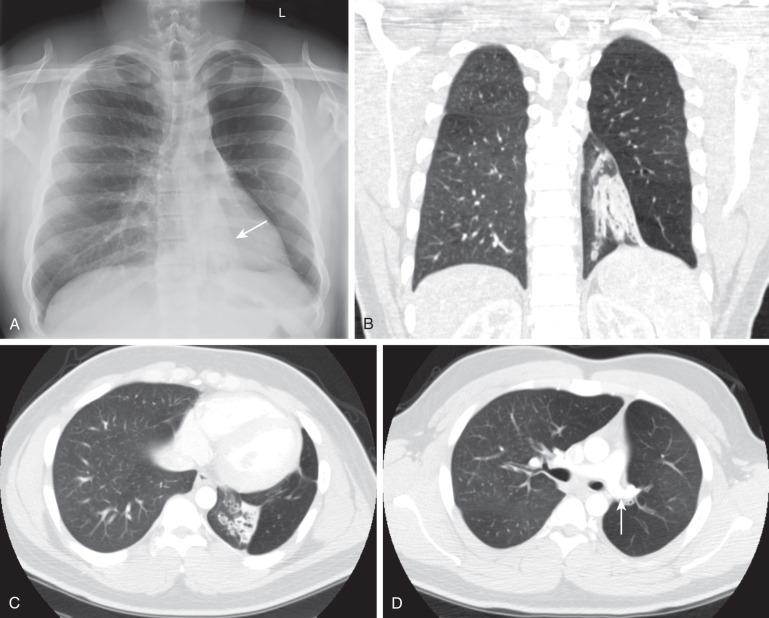
In RSV infection, the lungs are often quite clear, or focal areas of superimposed atelectasis may be noted (see Fig. 54.1 ); when present, these predict a need for more prolonged mechanical ventilation.
In mild influenza infection, initial chest radiographs are normal or may demonstrate nonspecific prominence of peribronchial markings and hyperinflation. In children with a more severe clinical course, bilateral symmetric and multifocal areas of consolidation, often associated with ground-glass opacities, are seen ( e-Fig. 54.3 ).
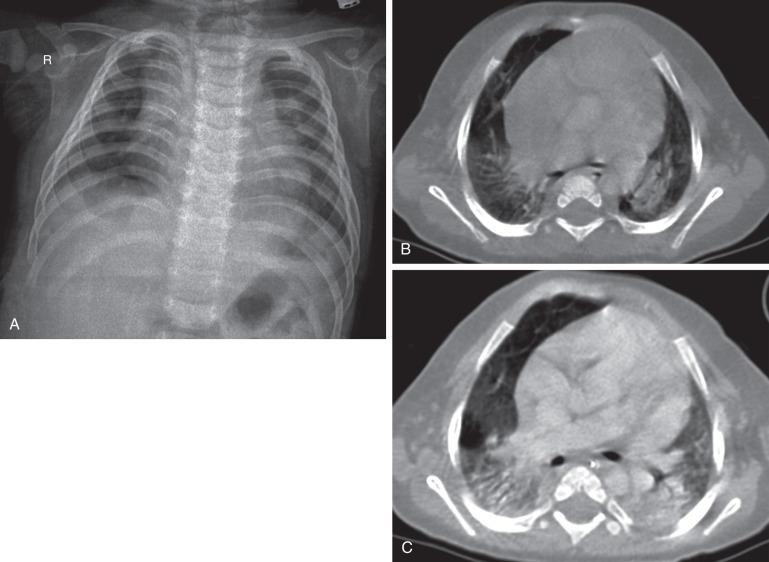
The radiographic manifestations of SARS are typically mild, with interstitial thickening, which may progress to focal consolidation. In children, unlike in adults, no lymphadenopathy, pleural effusion, or cavitation is reported. However, abnormalities may persist on thin-section CT in older children for up to 12 months after infection.
Measles virus is thought to be the cause of giant cell pneumonia, which produces a diffuse reticulonodular bronchopneumonia-like radiographic pattern ( e-Fig. 54.4 ), with hilar node enlargement and superimposed bacterial infection, usually affecting the lower lobes. Atypical measles pneumonia after vaccination with, or exposure to, live virus was characterized by extensive nonsegmental parenchymal consolidation, with pulmonary nodules, hilar lymph node enlargement, and pleural effusion being common.
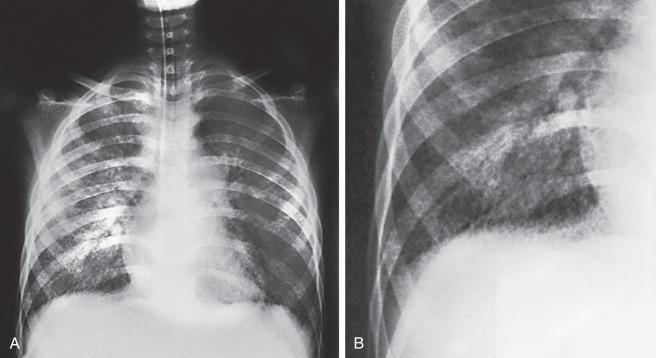
Adenovirus may cause necrotizing bronchopneumonia, bronchitis, or bronchiolitis. Radiographic features are nonspecific but usually include bronchial wall thickening, peribronchiolar densities, air trapping, and patchy or confluent consolidations. Adenopathy is more common than in other viral pneumonias. Bronchiectasis or bronchiolitis obliterans may be a permanent sequel (see e-Fig. 54.2 ).
In children infected with CMV, a progressive interstitial pneumonitis is seen ( e-Fig. 54.5 ). CT findings are nonspecific, with ground-glass opacities and consolidations in 80% of the cases. Gallium-67 scintigraphy may show abnormal uptake in the lungs of patients who have a normal chest CT.
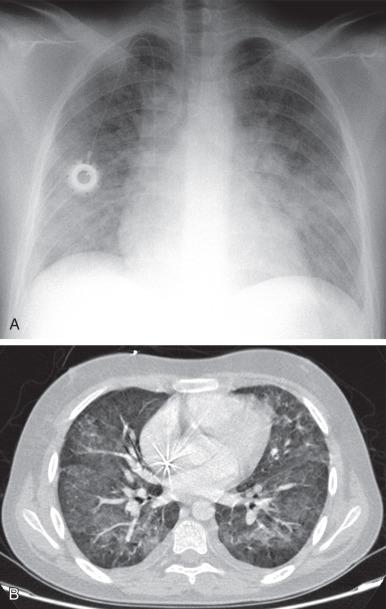
Findings in varicella are similar to those of measles pneumonia. Multiple focal calcifications frequently develop after severe chickenpox pneumonia ( e-Fig. 54.6 ).
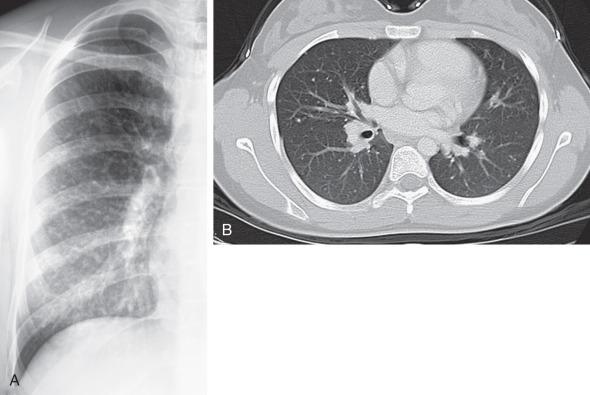
In EBV infection, hilar and mediastinal lymph node enlargement may be seen ( e-Fig. 54.7 ). Pulmonary involvement is uncommon but is characterized by bilateral reticular perihilar infitrates.
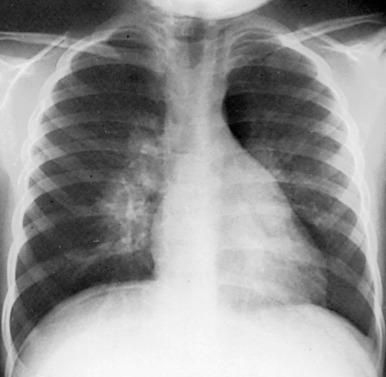
Effective antiviral therapies have not been established, and treatment of viral pulmonary infections is mainly supportive. Experimental treatments to correct the acquired surfactant deficiency and dysfunction that occurs in critically ill infants with viral pulmonary infections are actively being investigated. With a few exceptions, the use of extracorporeal membrane oxygenation to treat severe respiratory failure from ARDS, which frequently complicates severe infections, has not led to better outcomes than those of optimal less invasive supportive care. Certain high-risk infants may qualify for prophylactic injection of monoclonal antibodies against the F-glycoprotein of RSV. Because the most important complication of viral pulmonary infection is a superimposed bacterial infection, this should be actively looked for and treated with antibiotics when confirmed.
Bacterial pulmonary infections are acquired through inhalation, aspiration, hematogenously, or rarely by direct extension of chest wall or extrathoracic sites. Their course is determined by the balance between the virulence of the organism and the host immune response (mainly humoral, B-cell–mediated immunity, and macrophageal activity). They are characterized by alveolar airspace consolidation, visible as one or more focal lung opacities that exhibit air bronchograms and obliterate normal air–soft tissue interfaces (the silhouette sign). Pleural effusions are common. The most common bacteria and bacteria-like agents causing pulmonary infections in children are listed in Table 54.2 .
In young children, the classic segmental or lobar airspace consolidation is rarely present, and it is nearly absent in neonates. This is reflected by the reported low 30% positive predictive value of radiographic criteria for a bacterial cause of pneumonia, accounting for a widespread overprescription of antibiotics and development of antibiotic-resistant bacteria. On the other hand, the high 92% negative predictive value of radiographic criteria for bacterial pneumonia is helpful, allowing clinicians to withhold antibiotics in symptomatic children with a negative chest radiograph and to focus on other potential sources of the fever. It is therefore important not to overcall pediatric chest radiographs for the presence of a pulmonary infection, which is the most common interpretation error made by radiologists unfamiliar with pediatric imaging.
Clinically occult pneumonia may be diagnosed with radiography in up to 19% of children less than 5 years old with fever of unknown origin and leukocytosis, although a more recent study found a lower incidence (5.3%) and a low utility of radiography when cough was not one of the presenting symptoms in this setting.
Streptococcus pneumoniae is the most common cause of bacterial pneumonia in children less than 5 years of age. It is a gram-positive diplococcus that infects healthy patients but also commonly attacks those with underlying illness, including the hospitalized and immunocompromised, and children with sickle cell anemia. A strong association with a preceding viral infection, in particular influenza, is seen. The virally activated respiratory epithelium has an increased expression of receptors for pneumococcal attachment. In the usual case of an infected but otherwise healthy child, the onset is acute with fever, headache, and abdominal or chest pain with respiratory symptoms and signs. Rapid clinical resolution usually occurs within 24 to 48 hours after treatment with antibiotics in patients with uncomplicated infections. However, a rapid increase has been seen in the incidence of partially or fully penicillin-resistant strains of S. pneumoniae . After the institution of conjugate pneumococcal vaccination, the proportion of children younger than 5 years with suspected occult pneumococcal pneumonia confirmed by radiography decreased from 15% to 9%.
Pneumococcal pneumonia is usually confined to one lobe, but only rarely is the entire lobe consolidated. A pattern of homogeneous airspace consolidation is usual but not invariable, especially in the presence of underlying lung disease. This pneumonia may initially have a strikingly round appearance in children younger than 8 years ( Fig. 54.8 ), simulating an intrapulmonary mass or abscess, until it spreads further to reach a normal anatomic boundary such as a fissure. Large pleural effusion, empyema, and lung necrosis are infrequent complications, seen in less than 30% of patients. Resolution on radiographs is usually complete by 6 to 8 weeks.
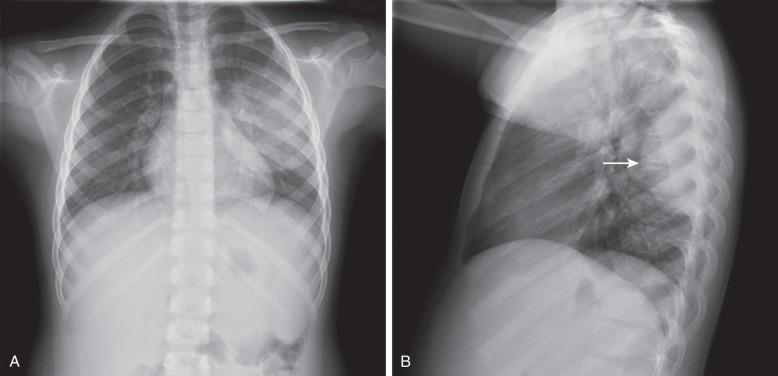
Group A streptococcus usually produces tonsillitis or pharyngitis. In the 1990s, S. pyogenes pneumonia, often associated with the toxic shock syndrome, was increasingly reported in childhood. It may occur de novo in a healthy child or follow a viral infection. In neonates, group B streptococcus is a leading cause of sepsis, including pneumonia and meningitis.
Group A Streptococcus produces a bronchopneumonia in a segmental configuration with either homogeneous or patchy consolidation, which frequently affects a lower lobe. It may be bilateral. Pleural effusion and empyema are common in untreated cases. Lung abscess may be a complication. Clinically and on imaging studies, this pneumonia is very similar to staphylococcal pneumonia, although pneumatoceles are less commonly seen. Group B Streptococcus may accompany or mimic hyaline membrane disease in neonates and is radiographically difficult to distinguish from it, although the presence of pleural effusion favors (concomitant) infection.
This gram-positive, catalase-positive coccus primarily affects infants under 1 year of age (70%). The incidence of “primary” staphylococcal pneumonia has decreased markedly since the early 1950s. However, staphylococcal pneumonia secondary to septicemia rather than inhalation of organisms is increasing and occurs in older children. This form of “embolic” disease may present with multiple nodular masses or abscesses ( e-Fig. 54.9 ). This evolving pulmonary pattern in a child with sepsis should initiate a search for a distant source of infection, often in bones, joints, or skin. Despite extensive pulmonary disease, if recovery occurs it is usually without sequelae. In comparison with methicillin-sensitive strains, methicillin-resistant strains of community-acquired S. aureus cause more serious pneumonias in younger children.
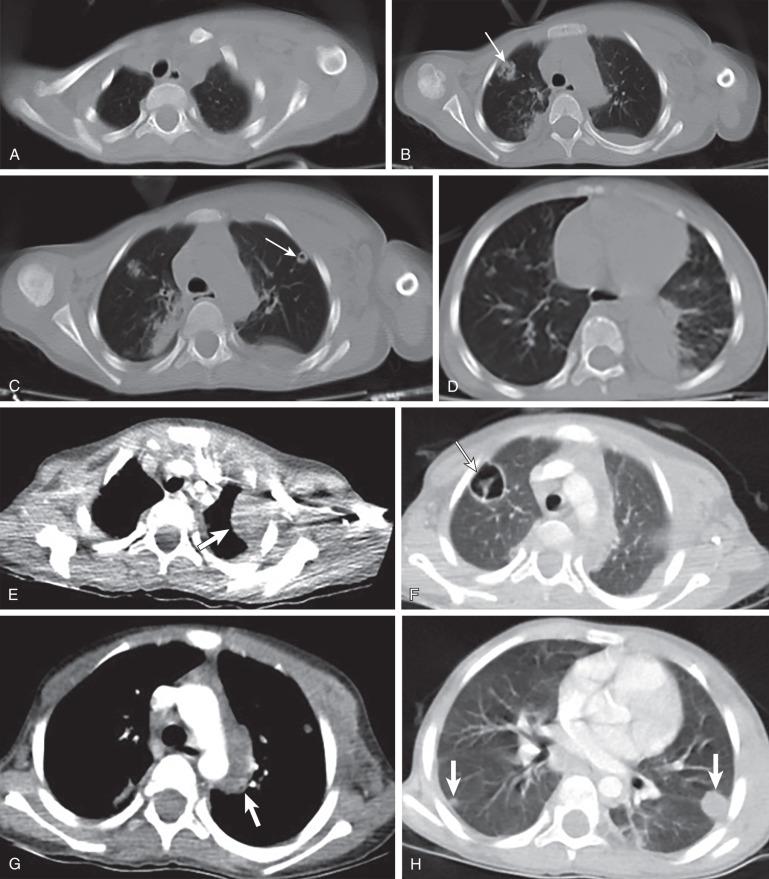
The more invasive and virulent strains of S. aureus, which carry the genetic marker Penton-Valentin leucocydin (PVL), are responsible for the most serious primary or metastatic infections of the lungs that are acquired in community settings.
In contrast to pneumococcal pneumonia, staphylococcal pneumonia is a lobular or bronchopneumonia, which begins in the airways rather than in the alveoli ( e-Fig. 54.10 ). Consolidation of peribronchiolar acinar units occurs initially in a segmental distribution. This infectious agent is very virulent, and severe hemorrhagic pulmonary edema may develop rapidly. Pneumatoceles are more common than in any other type (also reported in S. pneumoniae , H. influenzae , and Escherichia coli pneumonia) and occur in 40% to 60% of patients. Ten percent of children with staphylococcal pneumonia have a pneumothorax, which may result from the rupture of a pneumatocele. Pleural effusion and empyema are also very frequent, occurring in more than 90% of children ( Fig. 54.11 ).
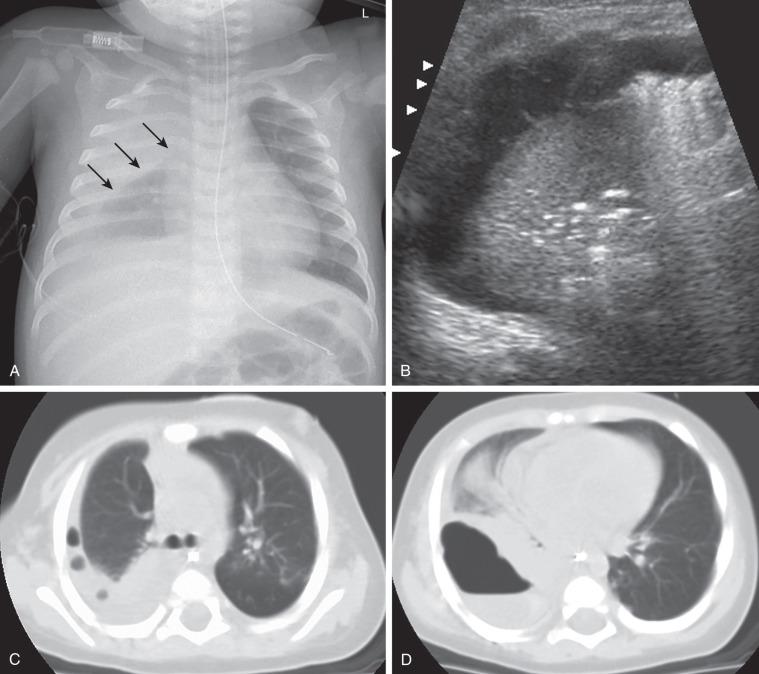
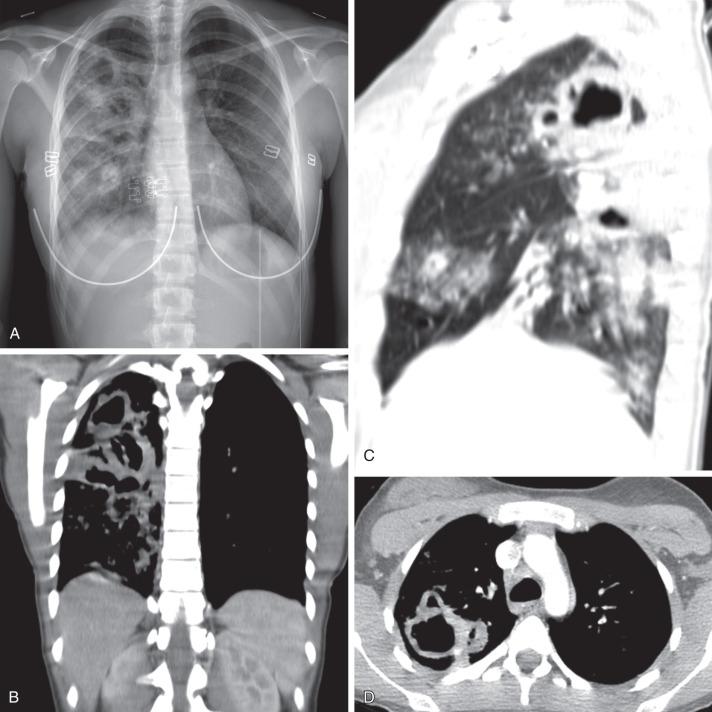
Haemophilus influenzae is a gram-negative, rod-shaped bacterium, which was first discovered in 1892 during an influenza pandemic. In infants and young children, it causes bacteremia, pneumonia, cellulitis, epiglottitis, and meningitis. Since 1990, vaccination has markedly reduced the incidence of this pneumonia (<95%).
The radiographic appearance of pneumonia due to H. influenzae is nonspecific: pulmonary opacities that often begin as a segmental, interstitial-appearing process progresses to airspace consolidation. Approximately two-thirds of cases have unilateral involvement, but more than one lobe is involved 25% of the time. Empyema is a common complication, occurring in about 40%.
Bordetella pertussis is a gram-negative, aerobic, capsulated coccobacillus. The incidence of pertussis (whooping cough) has decreased significantly with immunization, but it is still seen in young infants, particularly in the unimmunized. This agent is spread by airborne droplets. A characteristic clinical sign is the paroxysmal cough (whoop). Even after convalescence, the patient's cough may persist for weeks or months. In China the disease has been called “the cough of 100 days.”
Abnormal but nonspecific findings are present in most patients with pertussis. Because this is an airways-centered disease, it may mimic viral airways disease and pneumonia. The classic appearance is that of the “shaggy heart” ( e-Fig. 54.12 ). However, nonspecific findings such as hyperaeration, atelectasis, segmental consolidations, and hilar lymphadenopathy are seen more commonly. Bronchiectasis may be a long-term complication.
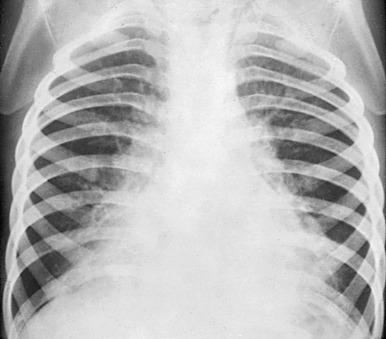
Pseudomonas aeruginosa is a gram-negative, aerobic, rod-shaped bacterium, which is an opportunistic pathogen in humans. Lungs, urinary tract, and kidneys are the common sites of infection. P. aeruginosa usually occurs as a nosocomial infection and is a major problem for patients with cystic fibrosis, in which thick layers of lung mucus and alginate produced by the bacteria may limit the diffusion of oxygen. Diagnosis of this infection depends on the Gram stain of sputum or other bacteriologic specimens (e.g., lung tissue, bronchoscopic aspiration, and bronchoalveolar lavage fluid).
When the patient is infected by airway contamination, the process tends to involve both lung bases, with extensive bilateral parenchymal consolidation, patchy areas of disease with small abscess formation, or small regions of lobular emphysema. In the bacteremic form, widespread patchy or nodular shadows may be found throughout both lungs. Lung necrosis may also occur.
Become a Clinical Tree membership for Full access and enjoy Unlimited articles
If you are a member. Log in here